NATURAL HEALTHY SUPPLEMENTS AND INGREDIENTS FOR AGRICULTURE, LIVESTOCK AND AQUATIC SPECIES
TERMINOLOGY & REFERENCES
South Florida Farming Humic Acids (HA) are 100% soluble powders made up of potassium humates, 65-70% humic acids and 10-15% fulvic acids. Humic acids (HA) are a product of the biotransformation of organic matter, which have been widely used in agricultural processes, bioremediation agents, as well as in animal production as a promoter of the improvement of productive parameters. The effect of humic acids on the development of animals in captivity is well documented. In chickens, HA have been shown to alter the intestinal flora, increasing beneficial bacteria, impacting the size of the crypts, reducing intestinal PH. Although the exact mode of action of HA is unknown, it has been shown to be natural growth promoters with antifungal, antiseptic, antioxidant, detoxifying and aflatoxin trapping properties. In chickens it has been used in both water and feed, observing improvements in digestibility, growth, conversion, egg production, egg mass, etc.
This product can be used in both water and food. In the food a dose between 2 to 10 kg per TM of balanced is recommended. In water it is recommended to put 250 g of product per TM of water, or a 25 kg bag for every 100 TM of water.
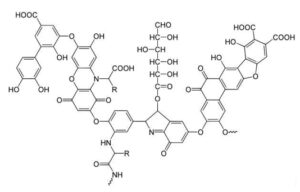
Average Chemical Formula of Humic Acids (C187H186O89N9S1)
The continuing pressure to decrease or eliminate the use of antibiotics as growth promoters has motivated the industry to develop antibiotic-free natural additives that can also improve the performance of animals in captivity. Currently, animal production processes demand clean production accompanied by competitive performance, management alternatives such as supplementation with food additives of natural origin, which improve production parameters and at the same time participate in the improvement of animal health, are the trend today. Tannins, Essential oils (EO) and Humic Acids are natural additives that have multiple nutritional and health benefits for animals used in Aquaculture and livestock. South Florida Farming (SFF) has developed the use of these products individually or in a mixture as an alternative to antibiotics or anticoccidials.
Essential Oils make up only a small portion of the plant’s wet weight (<1%). Most essential oils consist of a mixture of volatile products, and its effect is given by the sum of all its components. Additionally, the extraction method can determine the effectiveness of the active products. An example of this is the oregano extraction comparison, between steam distillation vs methanol extraction. The product generated by steam distillation has been shown to have antibacterial and antioxidant characteristics whereas the methanol extract has not.
South Florida Farming Essential Oils have shown antimicrobial effect on various pathogens in countless papers.
Minimum inhibitory concentration of some essential oils (in ppm, mg / L) (Krishan and Narang, 2014).
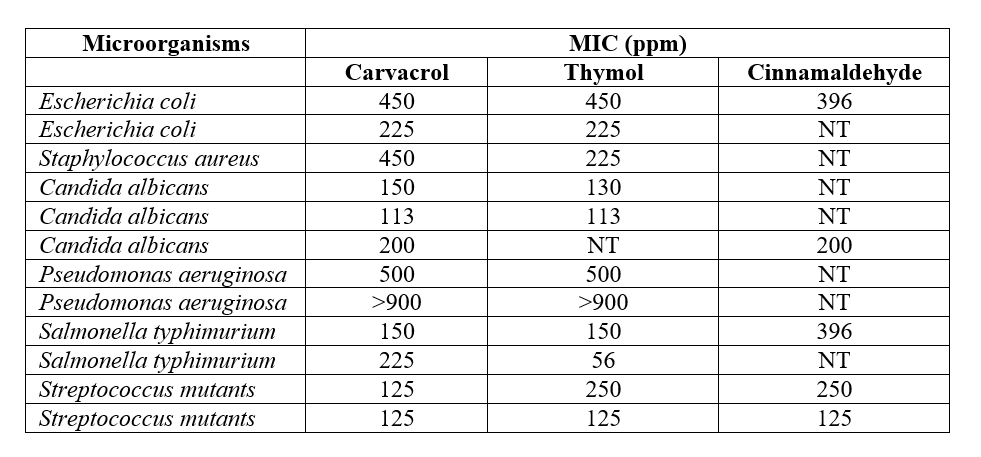
SFF Essential Oils (EO)

* Oregan oil is obtained by steam distillation of dried leaves of Oregano vulgare.
* Cinnamon oil is obtained by steam distillation of the dried bark of Cinnamomum zeylanicum.
* Clove oil is obtained by steam distillation of dried Syzgium arommaticum leaves.
* Thyme spp. Oil is obtained by steam distillation of dried leaves of Thyme spp.
All oils are Kosher grade, they do not contain genetically modified products, they can last in stable conditions for 24 months. Store in a warm, well-closed place that does not reach the light.
Carvacrol. Thymol, Eugenol and Cinnamaldehyde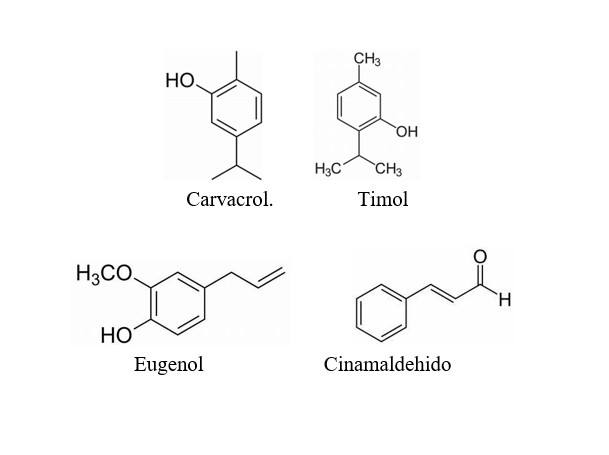
The recommended inclusion rate varies from 0.25 to 0.5 Kg of EO per MT in the feed. In the water from 0.25 to 1 mL of EO for each liter of drinking water.
Many important agricultural products, especially those rich in carbohydrates, are attractive colonization sites for fungi. Fungal (Mould) growth will produce mycotoxins. Mycotoxins are able to resist decomposition or being broken down by animal digestion, allowing these compounds to persist in meat and their byproducts. Mould growth can occur in the field as well as during processing and storage of harvested products and feed (spoilage).
Excess moisture is considered to be the most critical factor contributing to Mould growth. Grains stored at high relative humidity readily absorb excess moisture from the air. Mites and insects utilize the nutrients in grain and produce water as a metabolic byproduct and hence produce additional moisture sufficient for Mould growth. Temperature has been reported to have a direct effect on the rate of Mould growth and Mycotoxin formation, in general terms the higher the temperature, the greater the rate of growth and the higher the level of Mycotoxins produced.
They are several types of Mycotoxins, among them:
- Aflatoxins mainly produced by Aspergillus. Most common Aflatoxins are B1,B2, G1 and G2. M1 is a breakdown product from B1. B1 is the most toxic. Aflatoxins have been reported to have several serious deleterious effects in humans and animals. The target sites of this toxicant are also diverse, and effects include hepatotoxicity, teratogenicity, immunotoxicity, hematological disorders, renal dysfunction. A new approach to the detoxification of aflatoxins is the addition of inorganic sorbent materials, known as chemisorbents, such as hydrated sodium calcium aluminosilicate to the diet of animals. Aluminosilicates possesses the ability to tightly bind and immobilize aflatoxins in the gastrointestinal tract of animals, resulting in a major reduction in aflatoxin bioavailability.
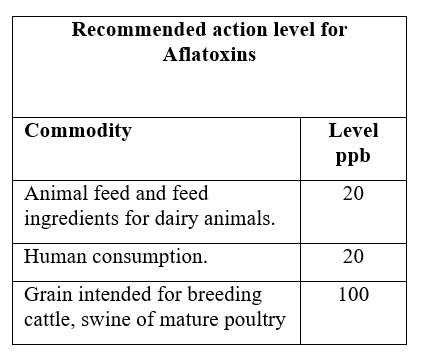
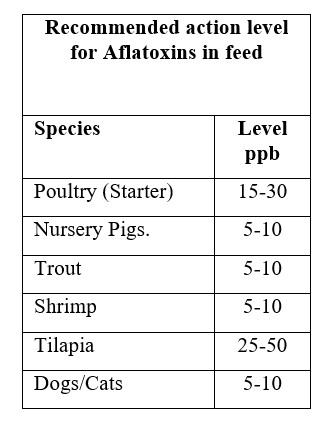
- Fumonisins: Are a group of naturally occurring mycotoxins produced by species of the fungi genus Fusarium. Although fumonisin metabolites have been found in many different grains, they are most commonly detected in corn and corn-based foods. Fumonisin found has 2 different varieties: the B1, B2 and B3. The most prevalent of these mycotoxins in contaminated corn is FB1, which is believed to be the most toxic Fumonisin in corn have been implicated in cases of porcine pulmonary edema, equine leuko encephalomalacia. Can also cause liver damage in multiple species including pigs, horses, cattle, rabbits, and primates. The levels of fumonisins in raw corn are also influenced by environmental factors such as temperature, humidity, and rainfall during pre-harvest and harvest periods. High levels of fumonisins are associated with hot and dry weather, followed by periods of high humidity. High levels of fumonisins may also occur in raw corn that has been damaged by insects.
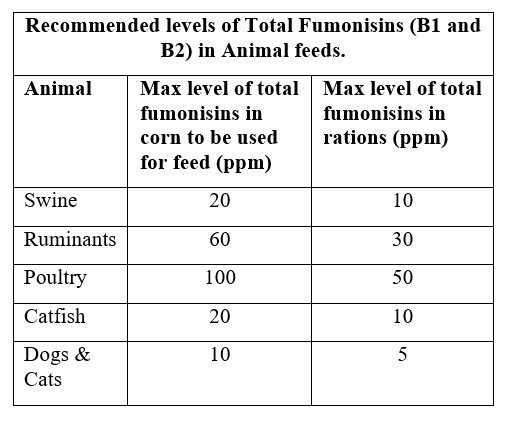
- Ochratoxins. are produced by fungi of the genus Aspergillus and Penicillium and have three derivatives as A, B and C. The most common and toxic type is Ochratoxin A (OTA). OTA is assumed to be one of the five most important mycotoxins in agriculture. The formation of mold and therewith also of OTA is supported by high temperatures and humidity. A wide range of agricultural processed or non-processed products can be contaminated, mainly cereals and cereal products and non-cereals. According to the International Agency for Research on Cancer, OTA is classified as a possible human carcinogen. It is made responsible for a variety of adverse health effects both in humans and in animals.
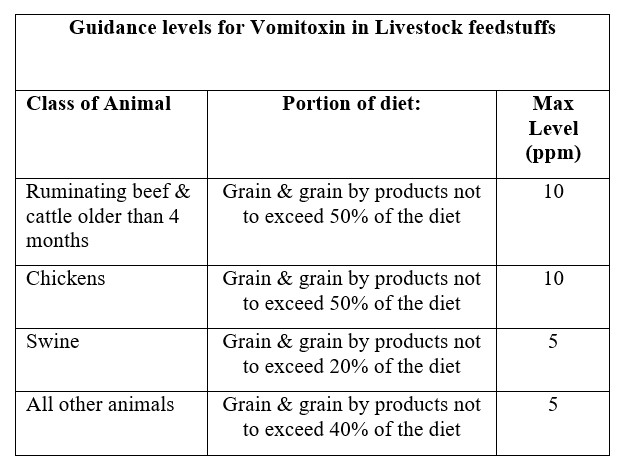
- Trichothecenes (Deoxynivalenol). Trichothecenes are one of the major classes of mycotoxins, causing a significant economic impact on cereal and grain crops each year. Trichothecene-producing genera include Fusarium, Myrothecium, Spicellum, Stachybotrys, Cephalosporium, Trichoderma, and Trichothecium. Trichothecenes are a family of over 200 toxins. They have been classified into four groups (Types A, B, C, and D). Type-A and B are the two types of fungal trichothecenes that often co- contaminate cereals. The most representative of Type A trichothecene group are T-2 toxin. Deoxynivalenol (DON), are the most commonly occurring and the best-characterized mycotoxins in Type B. Trichothecenes deleteriously affect protein synthesis by binding to ribosomes and inhibit DNA and RNA synthesis. Deoxynivalenol, colloquially known as vomitoxin, is the most commonly detected trichothecene, often at the ppm level.
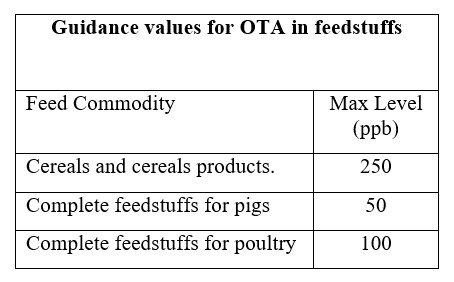 T-2 Toxin is not much known however it should be considered the critical level to be 0.1 ppm for cattle and poultry, and 0.025 ppm for dairy animals.
T-2 Toxin is not much known however it should be considered the critical level to be 0.1 ppm for cattle and poultry, and 0.025 ppm for dairy animals. - Zearalenone is principally resultant of the fungi Fusarium graminearum contamination of food commodities. When animals or humans are exposed to zearalenone at low levels, there may not be any visible symptoms as it has a low toxicity. However, when zearalenone is present in food at high levels or when there is consistent exposure at low levels, there have been reports of reproductive disorders and estrogenic effects. Exposure of farm animals to ZEA is a global public health concern because of its toxicity and wide distribution in animal feeds. ZEA is typically detected in high levels in samples of natural animal feeds, because of their improper storage, even though, toxigenic Fusariumspecies infect cereals and lead to ZEA accumulation before the harvest. Zearalenone is found worldwide in a number of cereal crops such as maize, barley, oats, wheat, rice and sorghum. It has been implicated in numerous mycotoxicosis in farm animals, especially in pigs.
Control of Mycotoxins by using feed additives.
The use of mold inhibitors such as propionic acid is widely used. It is important to note that protein or mineral supplements (for example, soybean meal, fish meal, and limestone) tend to reduce the effectiveness of propionic acid. These materials can neutralize free acids and convert them to their corresponding salts, which are less active as inhibitors. Dietary fat tends to enhance the activity of organic acids, probably by increasing their penetration into feed particles However, even if mould growth has been prevented, mycotoxins may still be present, because mould inhibitors have no effect on mycotoxins already present in the contaminated feed. Mycotoxin binders are sometimes needed to bind to mycotoxins and prevent them from being absorbed through the gut and into the blood circulation. Most of these products are efficient binders of aflatoxins but limited activity against other types of mycotoxins.
Silicate minerals are the most frequent mycotoxin adsorbing agent in the market. Several aluminosilicates clays such as hydrated sodium calcium aluminosilicate (HSCAS), bentonite, montmorillonite, smectite, and zeolite showed a good binding affinity with smaller mycotoxins, such as aflatoxin and ochratoxin A, but have less effect on larger molecules in certain Fusarium toxins. Cell-wall fraction β-glucan of yeasts such as Saccharomyces cerevisiae can alternatively be an effective substance in binding a wide range of mycotoxins. The capacity of yeast cell walls to adsorb flexible mycotoxins such as zearalenone and ochratoxins has been widely demonstrated. The adsorbing efficacy is very variable depending on the beta-glucan, MOS and chitin content of the yeast cell wall. Yeast cell walls show very limited efficacy to bind vomitoxin and fumonisins and even aflatoxins. pH has also been shown to be an important factor in the efficiency of mycotoxin binders.
In the search for natural solutions, humic substances (humic and fulvic acids) administered in the feed or drinking water are proving to be of interest. Humic substances are a class of compounds resulting from the decomposition of organic matter, particularly plants. Many studies and trials have showed their capacity to inhibit bacterial and fungal growth (decreasing levels of mycotoxins in feed), reduce stress by hormones, and improve the immune system, anti-inflammatory and antiviral properties, as well as to prevent and cure intestinal disorders. Humic substances also improve the nutritive value of feed and trace element utilization, with positive effects on growth performances and a reduction in mortality.
Our product SFF Multi spp Premix is 100% soluble organic powder, with an average composition between 65-70% as Humic and 10-15% Fulvic faction.
The tannins are obtained from fully sustainable extraction processes. These substances are rich in bioactive substances and their effect on chickens and pigs is well documented. They can help in the modulation of the intestinal microbiota, inhibition of pathogenic bacteria and viruses. They can also help to control the necrotic enteritis. They are an alternative to antimicrobials, natural growth promoters.
Antispasmodic activity in the gastrointestinal tract
Many plant extracts such as tannins have antispasmodic or spasmolytic effects, which among other things help to treat diarrheal diseases. The form of action is by delaying the gastrointestinal transit, decreasing intestinal motility by blocking serotonin (5-HT), which causes muscle spasms in the ileum and the proximal part of the colon.
Optimization of intestinal transit time.
The inclusion of 0.1% of Tannins in the diet increases the retention time of food in the intestine by 15%. The tannins in the diet work as a protector of the intestinal barrier.
The intestinal barrier is a functional unit organized as a multi-layered system. The first layer begins with the resident microbiota competing with pathogens for space and energy sources, processes the molecules necessary for the integrity of the mucosa and regulates the intestinal immune response. The next level is represented by the mucus layer. This layer is the first barrier that bacteria meet with the digestive tract. It consists of two layers, the inner one that is firmly adhered to the epithelial cells and the outer one that is looser and less adherent. This layer is where the intestinal flora lives.
Improvement of the quality of feces.
The most important effect is the prevention of episodes of diarrhea in birds, which can occur under stress conditions, is by keeping the feces with less moisture content. Drier feces are associated with better litter quality throughout rearing, a key factor in preventing plantar pruning, reducing odor emissions, avoiding anaerobic fermentation, and therefore creating a healthier environment for the welfare of broilers.
Reduction of foot pad injuries.
An obvious reduction in litter moisture is observed in several studies conducted at prestigious research institutes and commercial farms when supplementing broilers with Complex Tannins. Other results reported a reduction in nitrogen content compared to the control group, which resulted on a decline ammonia levels in the house. Claw pad dermatitis is a condition that causes necrotic lesions on the surface of the footpads of broilers. This is not just an animal welfare concern in many countries around the world, but also the reason behind losses and convictions in the sale of claws. Tannins at 0.1% in the poultry diet reduces the percentage of discard.
Necrotic footpad lesions are mainly due to deterioration of litter quality in terms of moisture, pH, and ammonia concentration. The best way to prevent these injuries is to keep the litter dry and loose by optimizing the composition of the bird’s diet.
Selective antibacterial and anti-cytotoxic effects, which favor the growth of beneficial bacteria: Improves the Relationship between Firmicutes / Bacteriodetes and Lactobacilli and Bifidobacteria
The gut microbiota of broilers plays an important role in the digestion and conversion of feed into meat and also in protection against pathogens, detoxification and modulation of the immune system. The ceca were used as sampling sites in many gut microbiotas studies. The ceca of poultry are digestive organs characterized by a very high bacterial diversity, where the bacteria of the phylum Firmicutes are more efficient in the use of food energy compared to those of the phylum
Bacteriodetes. The relationship between the phylum Firmicutes and Bacteriodetes in the intestinal microbiota has always been related to the efficiency in the incorporation of energy in different animal species, which suggests a correlation between the growth performance and the Firmicutes relation with Bacteriodetes (FBR). It was shown, in in vitro tests, that Tannins strongly inhibits pathogenic bacterial strains, including Pasteurella multocida, Campylobacter jejuni, Escherichia coli, and Clostridium perfringens, the latter the main pathogen responsible for necrotic enteritis. It is also important to note that C. perfringens does not develop resistance against Tannins. In fact, the level of sensitivity of C. perfringens increases strongly against antibiotics of chemical origin (bacitracin and avilamycin) after prolonged exposure to them, while in the case of Tannins the sensitivity remained unchanged. Due to its extensive surface and varied ecosystems, with thousands of microorganisms and compounds derived from digestion, which are continuously in contact with the intestinal tract. The role of the intestinal barrier is crucial to prevent pathogens from entering the blood and lymphatic circulation. The fundamental components of this protection are provided by the components of the intestinal mucosa barrier, which is made up of various physical, biochemical and immune elements. Keeping these components responsible for ensuring physiological functioning in the presence of pathogens is essential to maintaining intestinal health.
When the protection normally provided by the intestinal barrier fails, immune cells come into direct contact with luminal antigens. This can lead to deterioration of your normal mucosal functions. Recent data highlighted the possibility that the use of Tannins in the diet could improve the health of the intestinal barrier, by generating a thin layer to protect the intestinal mucosa (Lopetuso et al., 2015) and improving the integrity of the binding proteins intercellular (Liu et al., 2018).
Since the small intestine is responsible for the digestion and absorption of nutrients from food, an assessment of the intestinal structure should be included in the analysis of food additives such as tannins. The length of the intestinal villi is related to a better absorption area and increased digestive capacity (Uni et al., 1998). These are important characteristics for the digestive and absorption functions of the intestine. Tannins have been shown to protect the intestinal mucosa by maintaining a healthy intestinal microbiota and limiting inflammatory episodes.
In a field test, a much higher villus / crypt ratio is observed when treating birds with tannins, compared to chickens supplemented with APC (Figure 18). The results of the trial suggest a strong correlation between this effect on the height of the villi and the crypt / villus ratio, showing significant differences in both the duodenum and the jejunum.
Activity against some avian viruses and internal parasites
It was tested in vitro in Vero-infected cells against avian reovirus (ARV) and avian Meta pneumovirus (aMPV).
SCIENTIFIC PAPERS
- ACUTE MORTALITY
Passive surveillance for shrimp pathogens in Penaeus vannamei submitted from 3 Regions of Latin America
Nitrogen_Flow_in_a_Recirculating_Operation_of_Litopenaeus_vannamei_Maturation_in_Ecuador
Microbiological_dynamics_of_a_Litopenaeus_vannamei_hatchery_in_Ecuador_A
Inclusion_Fitobióticos_-_Alternativas_Promotores_Pollos_2024
Detection_of_a_novel_microsporidium_with_intranuclear_localization_in_farmed_Penaeus_vannamei_from_Latin_America
Acute_mortality_of_Penaeus_vannamei_larvae_in_farm_hatcheries_associated_with_the_presence_of_Vibrio_sp._carrying_the_VpPirAB_toxin_genes
SANITARY RECORDS
- Registro Sanitario